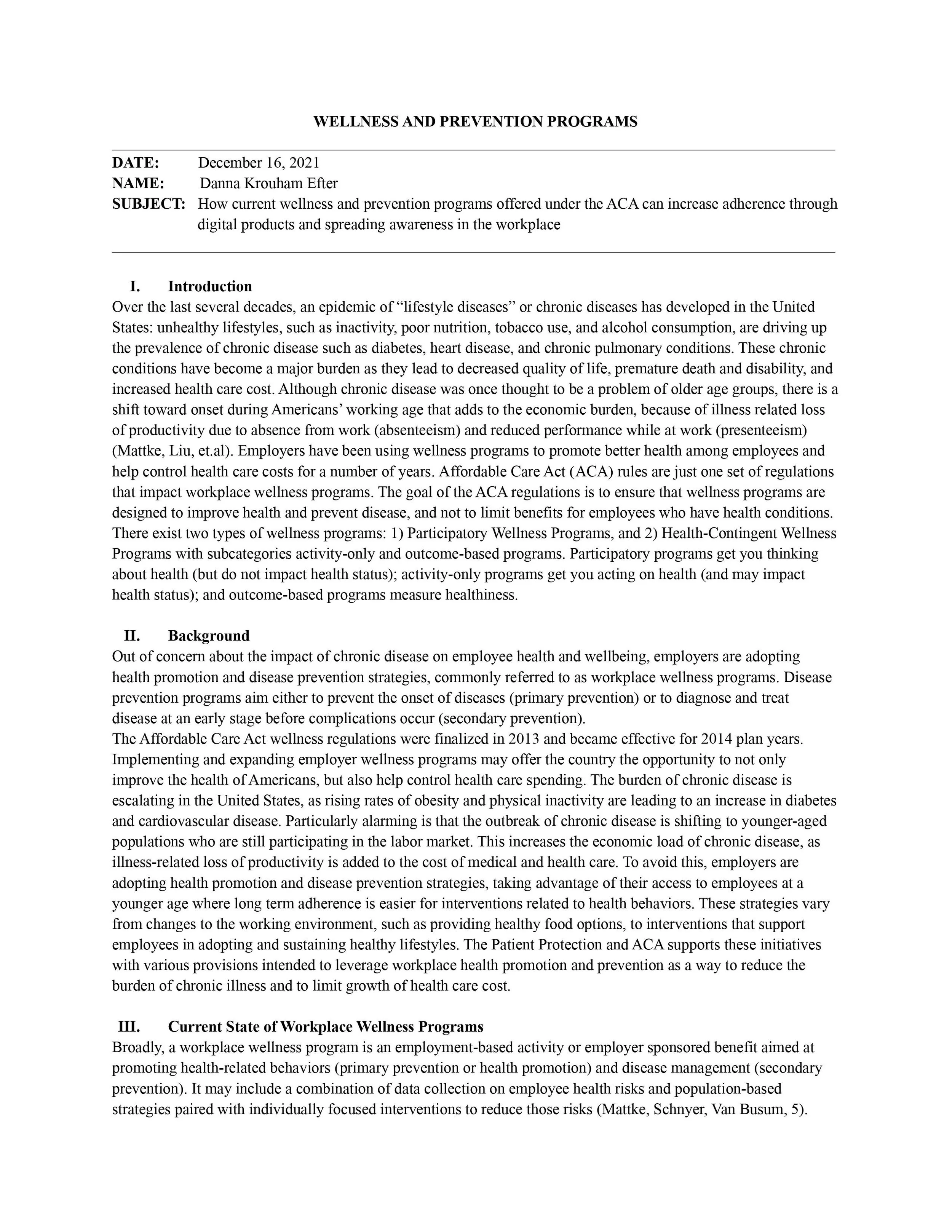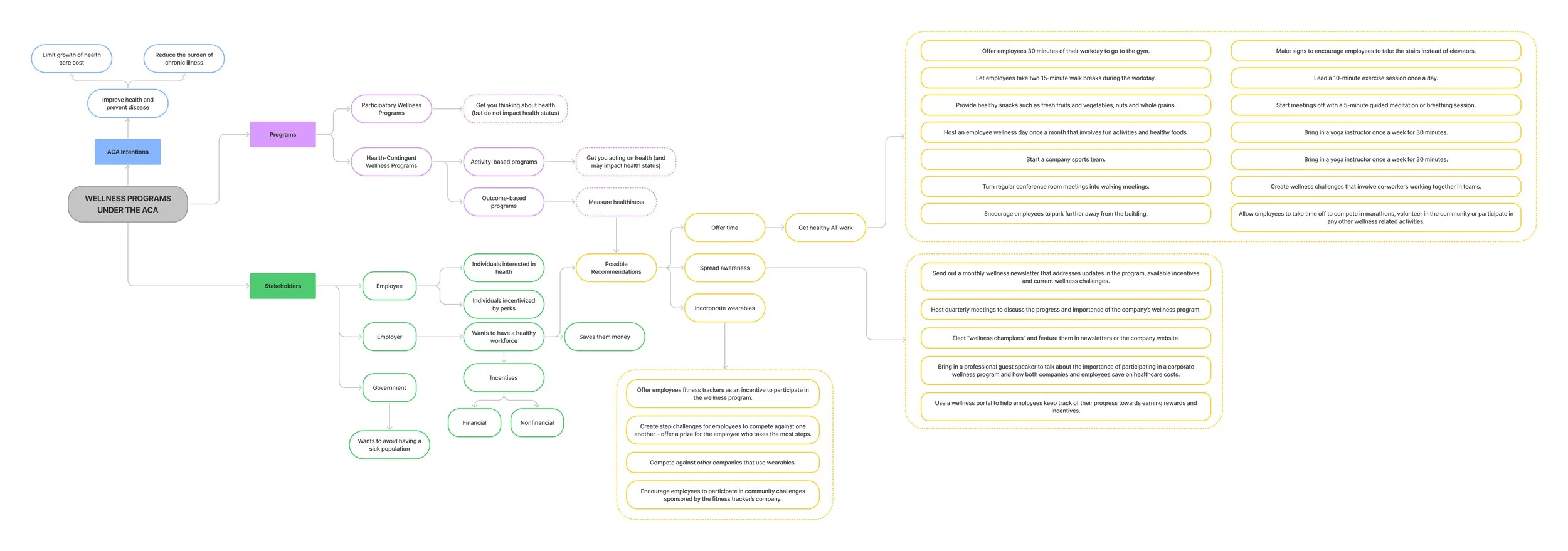Public Policy
HOW CURRENT WELLNESS & PREVENTION PROGRAMS OFFERED UNDER THE ACA CAN INCREASE ADHERENCE THROUGH DIGITAL PRODUCTS AND SPREADING AWARENESS IN THE WORKPLACE
Changing policies is really hard to do, but what if we can build upon what’s already available? I set out the task to tackle the wellness programs currently offered under the Affordable Care Act (ACA). The goal of the ACA regulations is to ensure that wellness programs are designed to improve health and prevent disease, and not to limit benefits for employees who have health conditions. There exist two types of wellness programs: 1) Participatory Wellness Programs, and 2) Health-Contingent Wellness Programs with subcategories activity-only and outcome-based programs.
How might we redesign wellness and prevention programs offered under the ACA to increase adherence through digital products and by spreading awareness in the workplace?
ROLE
Research / Strategy
TIMELINE
5 weeks
TEAM
Danna Krouham
Over the last several decades, an epidemic of “lifestyle diseases” or chronic diseases has developed in the United States: unhealthy lifestyles, such as inactivity, poor nutrition, tobacco use, and alcohol consumption, are driving up the prevalence of chronic diseases such as diabetes, heart disease, and chronic pulmonary conditions. These chronic conditions have become a major burden as they lead to decreased quality of life, premature death and disability, and increased health care cost. Employers have been using wellness programs to promote better health among employees and help control health care costs for a number of years.
BACKGROUND
Out of concern about the impact of chronic disease on employee health and wellbeing, employers are adopting health promotion and disease prevention strategies, commonly referred to as workplace wellness programs. Disease prevention programs aim either to prevent the onset of diseases (primary prevention) or to diagnose and treat disease at an early stage before complications occur (secondary prevention).
The Affordable Care Act wellness regulations were finalized in 2013 and became effective for 2014 plan years. Implementing and expanding employer wellness programs may offer the country the opportunity to not only improve the health of Americans but also help control health care spending. The burden of chronic disease is escalating in the United States, as rising rates of obesity and physical inactivity are leading to an increase in diabetes and cardiovascular disease. Particularly alarming is that the outbreak of chronic disease is shifting to younger-aged populations who are still participating in the labor market. This increases the economic load of chronic disease, as illness-related loss of productivity is added to the cost of medical and health care. To avoid this, employers are adopting health promotion and disease prevention strategies, taking advantage of their access to employees at a younger age where long-term adherence is easier for interventions related to health behaviors. These strategies vary from changes to the working environment, such as providing healthy food options, to interventions that support employees in adopting and sustaining healthy lifestyles. The Patient Protection and ACA supports these initiatives with various provisions intended to leverage workplace health promotion and prevention as a way to reduce the burden of chronic illness and to limit the growth of health care costs.
POSSIBLE INTERVENTION POINTS
-
Offer Time.
Because more than half of employees aren’t willing to devote an hour a day to wellness, employers should give them the opportunity to get healthy at work. Employees who are offered company time to complete wellness objectives, rather than being forced to do so with personal time, will be a lot more likely to participate.
-
Spread Awareness.
While employers might believe that their workplace wellness program’s rules and incentives are clear, some employees still might not understand how the program works – or why they should get involved. Keeping employees in the loop about incentives, financial rewards and the difference participation makes on healthcare costs can help motivate them to get involved.
-
Incorporate Wearables.
Employers should utilize the wearables that employees own to create a more exciting wellness program experience. Incorporating fitness trackers can also make an employer’s job easier, as the tracker does a lot of the work itself. Wearables can sync with wellness portals to input data such as step count, active minutes, and even sleep info.
Offering employees the time and convenience to complete wellness activities at work, educating them on the available incentives, and incorporating the use of wearables will attract and engage employees to participate in the journey towards a healthier, happier, and more productive life.


